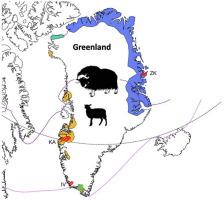International Journal for Parasitology ( IF 4 ) Pub Date : 2023-06-22 , DOI: 10.1016/j.ijpara.2023.05.005 Christen Rune Stensvold , Rebecca P. K. D. Berg , Jenny G. Maloney , Aleksey Molokin , Monica Santin

|
Molecular characterisation of endobionts that are shared among human and non-human hosts can help shed light on the epidemiology and inform studies that aim to unravel the role of these organisms in health and disease. Two of the most common of shared endobionts include the single-celled intestinal protists Blastocystis and Entamoeba. Here, we present the first known data on genetic diversity and host specificity of these two genera in Greenland. Faecal DNA samples from 243 muskoxen and 44 sheep were submitted to metabarcoding of nuclear small subunit ribosomal DNA. Entamoeba- and Blastocystis-specific sequences were clustered, and consensus sequences were subjected to taxonomic query. Using MinION-based sequencing, near-complete nuclear small subunit ribosomal DNA sequences were obtained from four faecal samples. Of the 243 muskox samples, 180 (74%) and 19 (8%) were positive for Blastocystis and Entamoeba, respectively. Forty (91%) and six (14%) of the 44 sheep samples were positive for Blastocystis and Entamoeba, respectively. Blastocystis subtypes (ST) 10, 14, 21, 24–26, and a novel subtype (ST40) were identified. Colonisation by more than one subtype was common. ST40 was common in muskoxen but limited to Northeast Greenland. Entamoeba bovis and the E. bovis-associated ribosomal lineages (RL) 1 and 8 were found, and three conditional lineages (CL) 3, 4, and 10 were confirmed; CL10 was promoted to RL12. Several novel lineages were identified, all of which were linked to the E. bovis complex. In conclusion, Blastocystis was far more common than Entamoeba and found in approximately three of every four animals; both can be considered common colonisers of large herbivorous mammals in Greenland. Multiple subtypes/lineages of both genera were commonly observed, some of which were novel, but most of which are seen in many other parts of the world.
中文翻译:

格陵兰麝牛和绵羊囊原虫和内阿米巴的分子特征
人类和非人类宿主共有的内生生物的分子特征有助于阐明流行病学,并为旨在揭示这些生物体在健康和疾病中的作用的研究提供信息。两种最常见的共享内生生物包括单细胞肠道原生生物芽囊菌和内阿米巴。在这里,我们展示了格陵兰岛这两个属的遗传多样性和宿主特异性的第一个已知数据。对来自 243 头麝牛和 44 只羊的粪便 DNA 样本进行了核小亚基核糖体 DNA 的元条形码编码。内阿米巴和芽囊菌-对特定序列进行聚类,并对共有序列进行分类查询。使用基于 MinION 的测序,从四个粪便样本中获得了接近完整的核小亚基核糖体 DNA 序列。在 243 份麝牛样本中,分别有 180 份(74%)和 19 份(8%)芽囊菌和内阿米巴呈阳性。44 份绵羊样本中,分别有 40 份 (91%) 和 6 份 (14%) 呈芽囊菌和内阿米巴阳性。鉴定出芽囊菌亚型 (ST) 10、14、21、24-26 和一种新亚型 (ST40)。超过一种亚型的定殖是常见的。ST40 在麝牛中很常见,但仅限于格陵兰岛东北部。牛内阿米巴和发现了牛大肠杆菌相关核糖体谱系(RL)1和8,并确认了三个条件谱系(CL)3、4和10;CL10升级为RL12。鉴定出了几个新的谱系,所有这些谱系都与牛大肠杆菌复合体有关。总之,芽囊原虫比内阿米巴原虫更为常见,大约每四只动物中就有三只发现了芽囊原虫;两者都可以被认为是格陵兰岛大型草食哺乳动物的常见殖民者。两个属的多个亚型/谱系都很常见,其中一些是新的,但大多数在世界许多其他地方都可以看到。



























 京公网安备 11010802027423号
京公网安备 11010802027423号